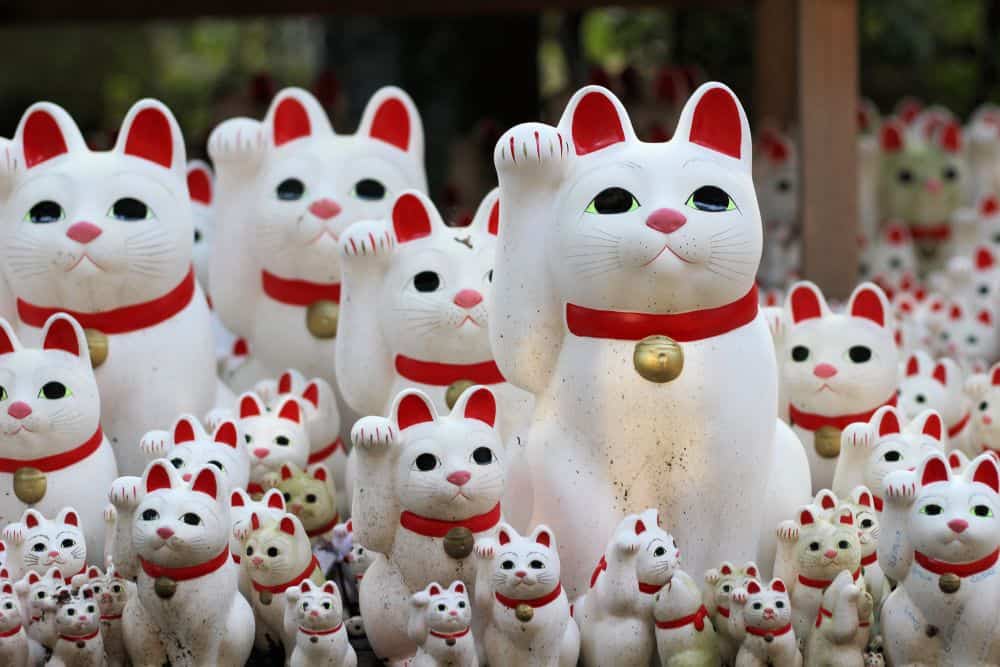
[Image above] Maneki-neko dolls at the Gōtoku-ji Temple. Credit: S., Flickr (CC BY-NC-SA 2.0)
With the crisp fall air settling into place for the season, students cannot help but feel the chill of midterms approaching. While studying is the best way to prepare for exams, it does not hurt to throw on that lucky hoodie you swear by before heading off to take the test.
Even if you are not superstitious, psychologists have shown that so-called “good luck” charms can help support positive outcomes by boosting someone’s confidence in their ability to succeed. While sometimes these charms are very personal, such as the lucky hoodie example above, many cultures have symbols or rituals that are widely viewed as lucky within that society.
The maneki-neko, or Japanese “beckoning cat,” is one cultural symbol that has grown to be recognized almost universally as a figure of good luck. With October being a difficult time for black cats and kittens, today we’ll look at the history of maneki-neko and specifically why black ones should be viewed as protectors rather than harbingers of misfortune.
The rise of maneki-neko: Edo temples and shrines claim their own unique legends
Maneki-neko style Japanese cat dolls can be traced back to the Edo period (1603–1868), an era of wealth, relative peace, and flourishing arts. The period was an idyllic time for cats as well—an imperial decree in 1602 set all cats free in Japan, intending to capitalize on the felines’ natural ability for pest control, as reported in National Geographic.
The maneki-neko dolls are believed to have first appeared in several Buddhist temples and Shinto shrines in the city of Edo (present-day Tokyo). Each of these places of worship claim their own unique story of how the maneki-neko came to be. Two of the most well-known legends about maneki-neko are given below.
Gōtoku-ji Temple (Setagaya City special ward)
While passing Gōtoku-ji Temple, lord samurai Ii Naotaka (1590–1659) of the Hikone domain was beckoned by a cat at the temple gate. Once he entered the temple, an unexpected heavy thunderstorm started pouring down.
In gratitude for being saved from the storm, Ii Naotaka decided to provide continuous donations to Gōtoku-ji Temple, which had been struggling financially. The cat became the temple’s symbol and brought them continuous good fortune.
Imado Shrine (Taitō special ward)
In 1852, an old woman living in Imado was so poor she could no longer feed her pet cat and regrettably let it go. That night, the cat appeared to the lady in a dream and said, “If you make dolls in my image, I will bring you good fortune.”
Following the cat’s instructions, the old woman made some cat figurines from Imado ware, a type of local terracotta ceramics, and went to a shrine to sell the figures at the gates. The ceramic cats became very popular, saving the old woman from poverty.
From local ceramics to molded mass production
As noted in the Imado Shrine legend above, maneki-neko dolls originally were created out of local clays by individual artisans. But as the symbol gained popularity, mass production by using plaster molds allowed the ceramic cat to spread quickly throughout Japan during the Meiji era (1868–1912).
The maneki-neko dolls experienced several design changes during this time. The original cats wore only a bell around their necks, as can be seen in great print master Utagawa Hiroshige’s ukiyo-e style woodblock print from 1852 (see top left stall in the accompanying image). However, the bells started to be replaced with ryō, an oval-shaped Japanese gold coin, to represent wealth.
Additionally, the original maneki-neko dolls were designed to look very realistic. But in the 1950s, makers in Aichi Prefecture started giving the cats bigger heads and wider eyes, similar to the style of the Okkawa Ningyo dolls from that prefecture.

The images below demonstrate this evolution in maneki-neko design.

The color variations of maneki-neko
The original maneki-neko dolls were calico, featuring a combination of white, black, and orange. But when the ceramic cats started to become widely associated with Chinese feng shui, the figurine started being offered in different color variations, each with their own meaning.
- Calico or white (original color): happiness and purity
- Black: protection against evil spirits and malicious people
- Gold: wealth and prosperity
- Red: good health and protection against disease
- Pink: romance
- Green: success in education
- Blue: wisdom and success
Notice in particular bullet point number two. In this case, black cats are viewed as protectors against evil, rather than evil spirits themselves, as they are often portrayed in U.S. media. Japan is not the only country where black cats are viewed as good luck—see this list of other cultures that have positive superstitions about black cats.
Make your own maneki-neko doll
While buying a maneki-neko doll from a store is easy enough, people typically derive more value from good luck charms that hold personal meaning to them. As such, why not try making a maneki-neko doll of your own?
The video below provides an easy step-by-step process for sculpting your own maneki-neko out of air-dry clay—the perfect afternoon activity for students taking a break from mid-term cramming!
